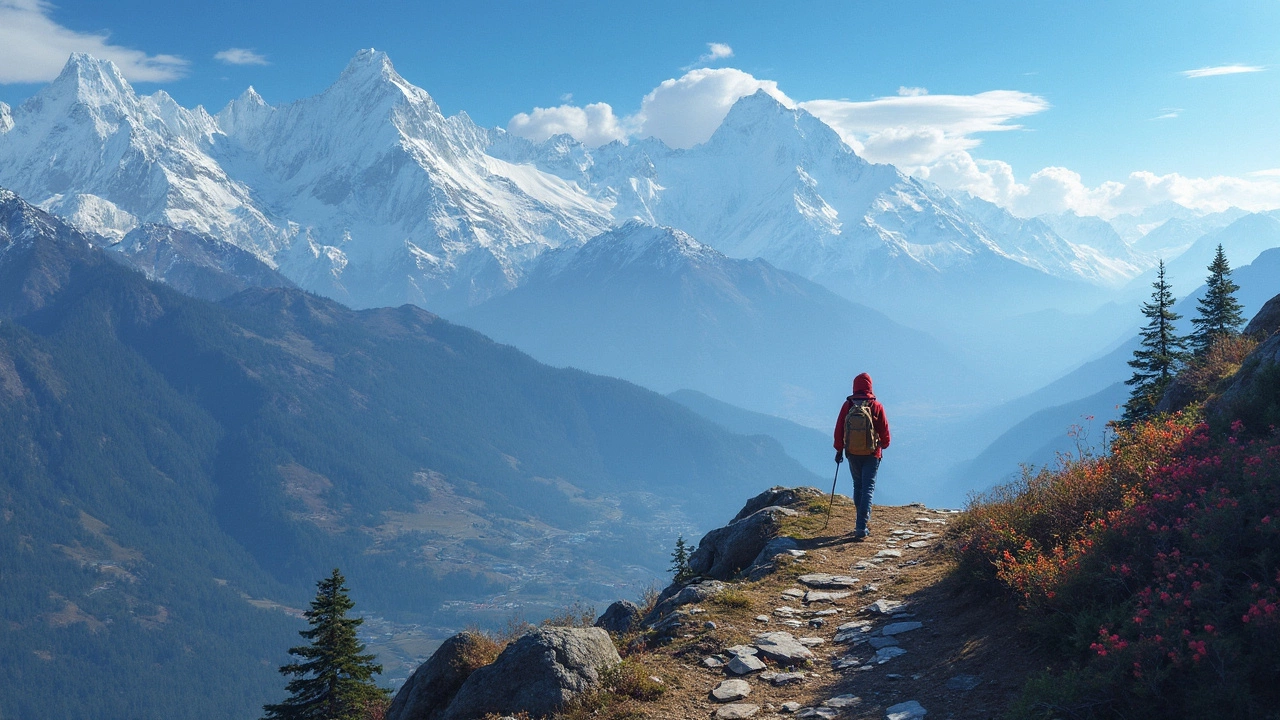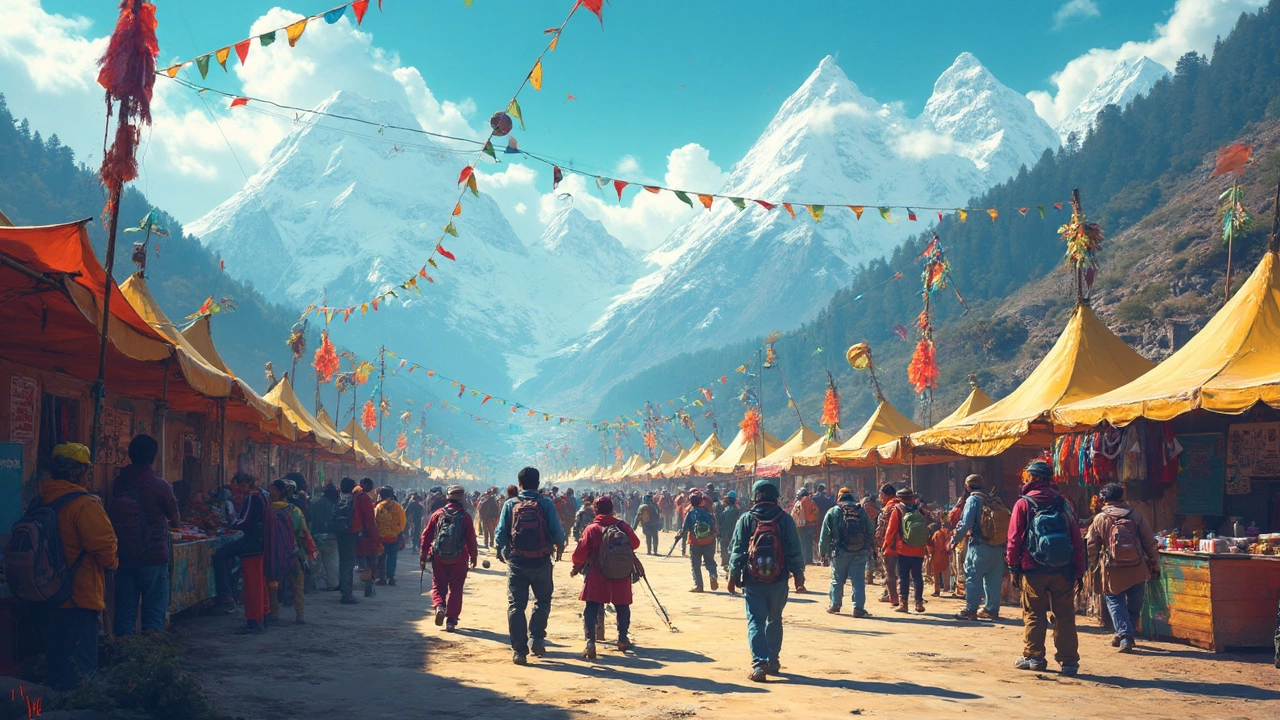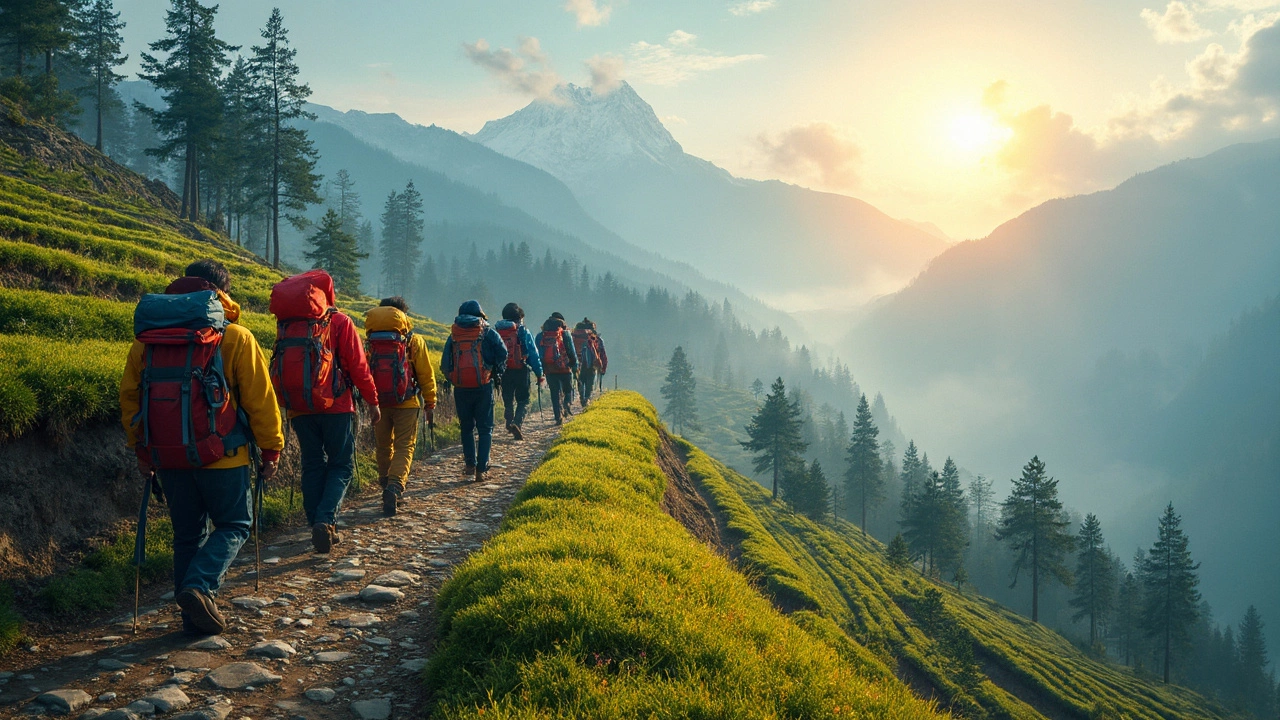Ask any seasoned trekker about the best place to lace up your boots in India, and you’ll hear Himachal Pradesh pop up again and again. If you’re itching for trails that twist through pine forests, pass frozen lakes, and open up to wild mountain valleys, this state is where the action’s at. We’re not just talking about one or two famous spots—Himachal is packed with trails for rookies and hardcore hikers alike.
Jumping into its hiking scene is way easier than you think. From easy walks near tiny villages to steep climbs that’ll test your legs, there’s something for everyone. Manali and Dharamshala? You’ll find them packed with backpackers swapping stories and kicking back after a long day on the trail. Want something more remote? That’s covered too. Himachal has a knack for surprising even the most jaded trekkers.
This state isn’t just about pretty views—it’s wired for adventure, with trail markers, guesthouses, and even cozy tea stalls popping up where you’d least expect. If you’re hunting for the hiking capital of India, this is where fun meets challenge, all bundled together in one mountain-packed package.
- Why Himachal Pradesh Wears the Crown
- Top Trails You Can't Miss
- Hidden Gems and Lesser-Known Routes
- When to Go and What to Pack
- How to Plan Your Trek Like a Pro
Why Himachal Pradesh Wears the Crown
If you’re chasing the real deal for trekking, Himachal Pradesh leaves other destinations in the dust. The state has become the hiking capital of India for a bunch of pretty solid reasons—let’s dig in.
First off, location is everything. Himachal sits smack in the lap of the Himalayas, so you get full access to jaw-dropping peaks, thick forests, and endless alpine meadows. But it’s not just about epic backdrops—the variety here is wild. You want gentle treks to introduce your kids to the outdoors? Check. High-altitude routes that make your selfie game next level? Double-check.
Himachal isn’t just for pros. Beginner-friendly trails like Triund and Prashar Lake are as welcoming as they are scenic, and you don’t even need lots of gear. For thrill-seekers, there’s the Hampta Pass or the Indrahar Pass, where altitude, not just distance, really tests you. And here’s something a lot of folks don’t realize: Himachal is probably the only state where you’ll spot trekkers hopping villages and ending their day at a chai stall in the middle of nowhere.
Getting in and getting around is easier than most expect. Major trekking hubs like Manali and Dharamshala pair good transport links with affordable stays and plenty of gear shops. And you’re never short on company—locals love to share stories, and it’s easy to hook up with like-minded hikers from all over the world.
Need numbers? Just look at the official count: Himachal sees over 2 million adventure tourists every year, with trekking topping the to-do list. Agencies and homestays now build full seasons around this demand, so you get better guides, safer trails, and more options for every budget.
- Biggest choice of marked trekking routes in India
- Massive range: easy to tough trails, short to long durations
- Reliable weather windows from spring to early autumn
- Home to cross-cultural Himalayan villages and stunning scenery
- Strong support system: guides, gear rentals, guesthouses everywhere you need them
Bottom line? Himachal Pradesh isn’t just famous—it’s practical, fun, and always ready for more trekkers. That’s why it holds the crown.
Top Trails You Can't Miss
When people think about trekking in India, the hiking capital of India delivers some of the wildest and most popular trails. Himachal Pradesh is loaded with options, from easy routes to your first big mountain trek, to tough climbs that pull in seasoned hikers from across the globe. Here are a few stand-out trails you can't ignore if you're heading here.
- Triund Trek: Just outside McLeod Ganj near Dharamshala, you get a trail with a big payoff for a relatively easy climb. Views of the Dhauladhar Range and Kangra Valley are a massive hit. Most folks finish in a day, but spending a night under the stars is totally worth it.
- Hampta Pass: This one is a fan favorite for its sudden scenery switch. You start in green Kullu Valley and cross over to the stark, high-altitude Lahaul desert. Four or five days is all it takes, but you’ll see some of the craziest changes in landscape on any trek in India.
- Beas Kund: Perfect if you're pressed for time but want real adventure. In just two or three days, you’ll get up to a beautiful glacial lake surrounded by big peaks. This route is great for slightly experienced beginners.
- Pin Parvati Pass: This is for trekkers hunting for a challenge. The route is long—about 110 km over 10-12 days—and throws high-altitude weather and tricky terrain your way. It’s not for first-timers, but it’s famous for its mix of meadows, rivers, and one wild mountain pass.
- Bhrigu Lake: A popular weekend trek from Manali, especially if you want to hike at high altitude fast. Locals say the lake never fully freezes, even in dead winter. The hike takes just 2-3 days, making it one of the best short options.
Every year, thousands of trekkers hit these trails. According to the Himachal Pradesh Tourism Department, over 200,000 hikers registered for official treks in the region in 2023 alone.
| Trail | Duration | Difficulty |
|---|---|---|
| Triund | 1-2 days | Easy |
| Hampta Pass | 4-5 days | Moderate |
| Beas Kund | 2-3 days | Easy-Moderate |
| Pin Parvati Pass | 10-12 days | Hard |
| Bhrigu Lake | 2-3 days | Moderate |
For folks chasing variety, these treks show off everything from sweeping alpine meadows to fierce snowy ridges. There’s something for every level. As experienced trek guide Suman Rawat put it:
“Himachal Pradesh doesn’t just give you a good walk, it changes your idea of what hiking can be.”
So, whether you want a quick escape or an epic mountain adventure, you know which trails to check first.

Hidden Gems and Lesser-Known Routes
If you think you’ve seen everything Himachal Pradesh offers, think again. Beyond the famous treks, the state hides some low-key trails that barely show up on Insta feeds but deliver big on adventure and solitude. These aren’t tourist traps—you’ll find mostly locals or hardcore trekkers on these paths.
The Kugti Pass trek is one many folks skip. It’s in the Chamba district and takes you through old shepherd villages right up to the shoulder of Mount Manimahesh. Fewer than 200 people try this trek each year, which keeps the vibe chill and authentic. The altitude here goes up to 16,600 feet, so you get bragging rights without the crowds.
Then there’s the Gushaini to Sarchi trail in the Tirthan Valley. It’s a solid pick if you’re into river crossings, wobbly wooden bridges, and apple orchards. Plus, the trail mixes forest walks with open stretches, so you never get bored. Don’t expect luxury—most nights are spent in local homes or simple camps, but that’s what makes it real.
Pangi Valley, reached from Keylong or Chamba, feels like a lost world. Its trekking routes, like the trail to Killar and the Saach Pass, are raw, twisty, and offer jaw-dropping views without the classic Himachal crowds. This is where you want to go if you’ve already ticked off the big-name treks and need something wilder.
- Best tip: Local guides know these routes better than any app. Seriously, don’t skip out on their advice—they keep you safe and add loads to the experience.
- Check trail conditions before you go. Some routes get blocked by landslides or snow, sometimes all the way into June.
- Pack light, but take good rain gear. Sudden storms are common even in late spring and early autumn.
If you’re after the real deal for the hiking capital of India, these offbeat routes show you a different side of the mountains. You get quiet, connection with local life, and that sweet sense of discovery every step of the way.
When to Go and What to Pack
Timing your trek in Himachal Pradesh makes a huge difference. Most folks hit the trails between late March and June or from mid-September to November. Why? Spring and early summer bring blooming rhododendrons and clear weather, while fall is known for crisp air and stellar mountain views. Monsoon months (July-August) are best avoided—landslides and slippery trails aren’t worth the risk.
If you’re dreaming of tackling snowy trails or ice lakes, January and February can be magical but tough. Only plan these winter treks if you’ve got the right gear and some solid experience under your belt.
Now, what should you actually toss into your backpack? Everyone has a packing disaster story, so here’s how to skip that drama:
- Layered clothing: Weather changes fast here. Quick-dry t-shirts, warm fleece, and a down jacket work wonders.
- Good hiking boots: Break them in at home—nothing worse than blisters mid-journey.
- Rain gear: A waterproof jacket and backpack cover, especially if you’re hiking pre- or post-monsoon.
- Reusable water bottle and snacks: No one wants to run out of fuel halfway up a hill.
- First aid kit: Include painkillers, band-aids, basic meds, and any personal prescriptions.
- Sunscreen and sunglasses: Even on cloudy days, UV rays are sneaky up in the hills.
- Trekking poles: Super handy for long descents and tricky sections.
- Power bank and headlamp: You’ll want a charged phone, and trails get dark quickly after sunset.
- ID proof and permits: Most major treks require them—get this sorted before you go.
Here’s a quick look at how the main hiking months stack up:
| Season | Avg. Temp (°C) | Highlights |
|---|---|---|
| March - June | 15-25 | Wildflowers, clear trails |
| July - August | 18-22 | Heavy rain, muddy paths |
| Sept - Nov | 10-20 | Clear skies, vibrant colors |
| Dec - Feb | 0-10 | Snow, advanced treks only |
Double-check the forecast, keep your gear light but complete, and you’ll save yourself a ton of hassle. That way, you’ll actually enjoy the views and not just fight to stay dry or warm on your adventure in the hiking capital of India.

How to Plan Your Trek Like a Pro
Getting set for a trek in Himachal Pradesh isn’t rocket science, but a bit of planning means you dodge the rookie mistakes. First up, pick your route based on how fit you are, the time you have, and what kind of scenes you want. Short on time? The Triund trek near Dharamshala takes just a weekend. Ready for something bigger? The Hampta Pass trail will have you crossing rivers and glaciers over a few days.
Put together the right gear. You want layers, not bulk, because weather up in the mountains doesn’t play by the rules. Think moisture-wicking shirts, a solid windbreaker, and a light but warm jacket. Don’t forget broken-in boots and a headlamp. Most folks underestimate how cold it can get after sunset, even in May or June.
- Hiking capital of India has trails where signals get weak fast, so always carry downloaded offline maps (like those from Maps.me or Google Maps).
- Most Himachal treks—think Beas Kund or Kheerganga—have basic guesthouses or campsites along the way, but you should still book ahead, especially in peak season (May-June).
- Check if your trek needs permits. For example, Rohtang Pass requires an environmental permit, which you can get online.
- It pays to pack snacks like nuts, dry fruit, and energy bars. Food stalls don’t always pop up when you need them.
If you’re trekking above 2,500 meters (about 8,200 feet), take it slow. Altitude sickness is real, and even fit hikers can get hit. Drink loads of water (at least 2-3 liters a day) and pause if you feel dizzy or short of breath.
Here’s a quick breakdown of key things to lock in before your trek:
| Task | When to Sort It |
|---|---|
| Book transport & permits | 2-4 weeks in advance |
| Check trail & weather updates | 48-72 hours before |
| Pack and test gear | At least 1 week before |
| Book first-night stay | 1-2 weeks before |
Travel light, double check your essentials, and always tell someone your route and return date. Himachal’s trails are epic, but there’s no rescue if you’re missing and no one knows where you went. Get these basics right, and you’ll have adventure stories worth bragging about for years.
